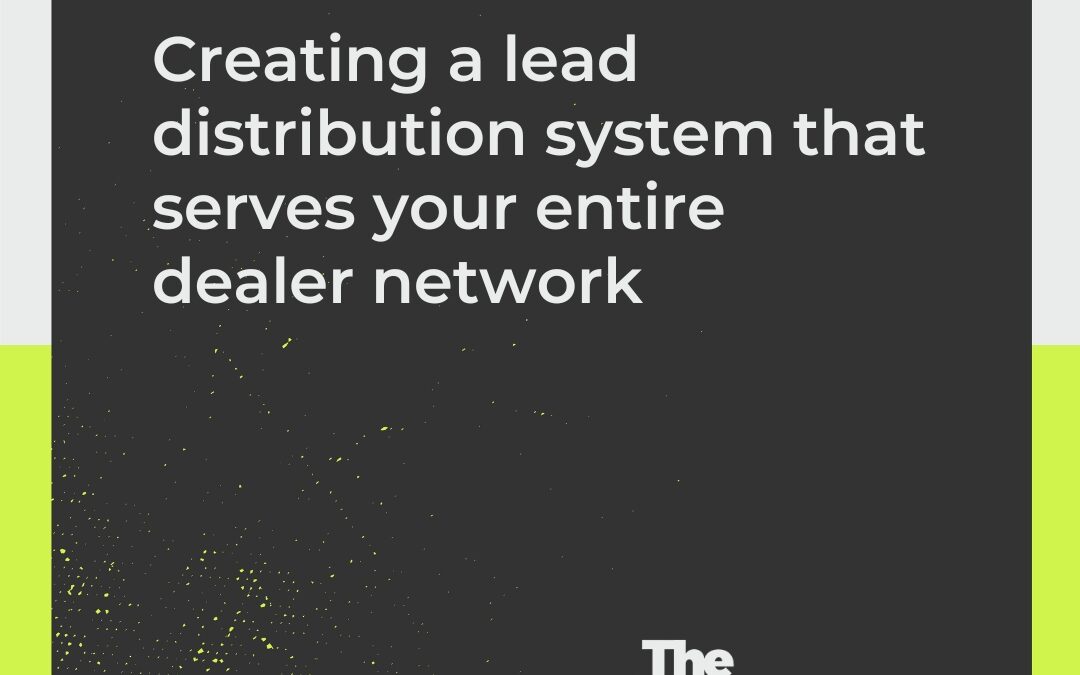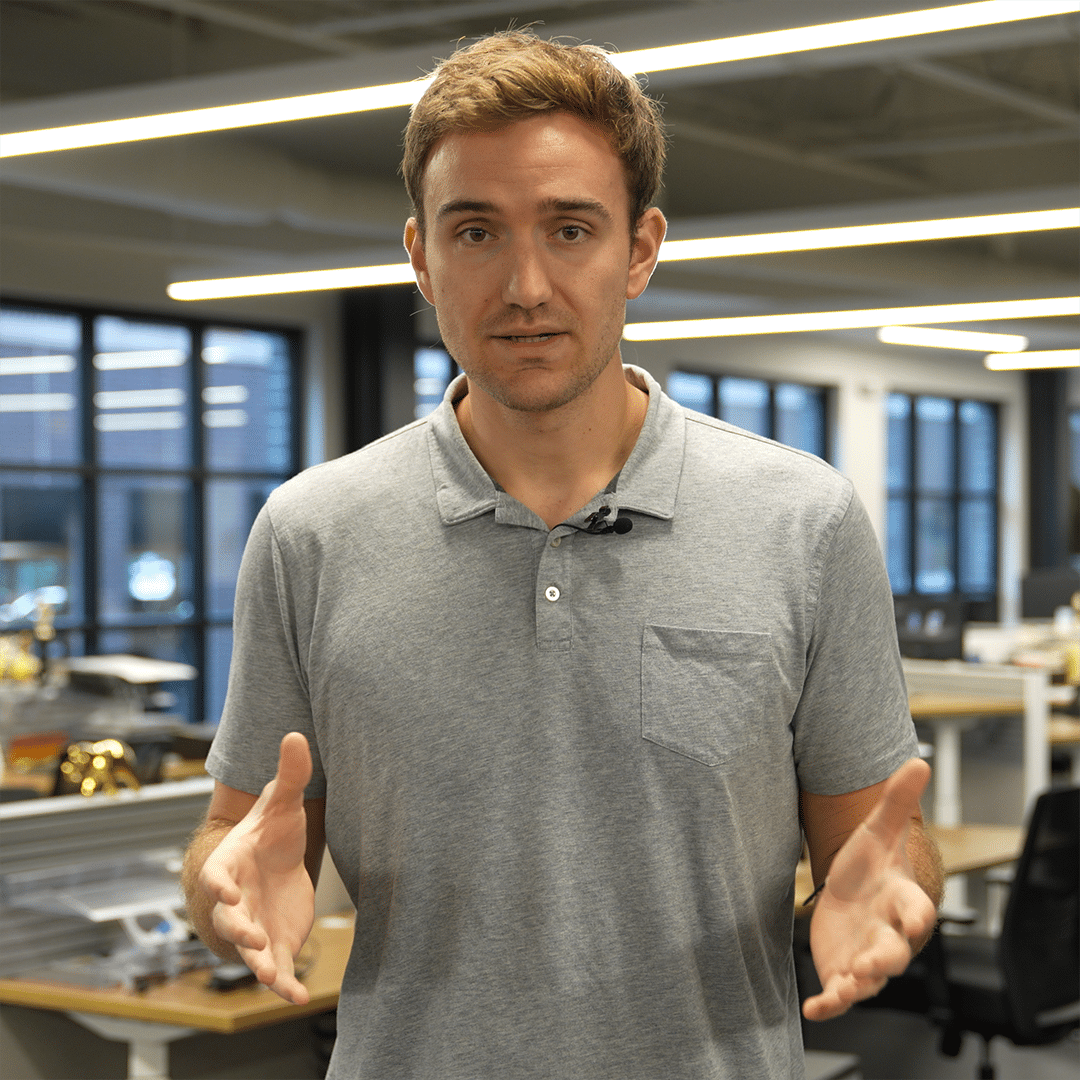Creating a Lead Distribution System that Serves Your Entire Dealer Network
The Inventory
This Episode
Distributing leads effectively can be a real challenge. How do OEMs ensure quality leads reach the right dealers at the right time, while also maintaining a positive customer experience?
In this episode, Joe Mills talks with Dustin Clark, VP of Digital at Element Three, about the complexities of lead distribution. They explore how to cater to dealers with different levels of sophistication and what OEMs can do to ensure leads are handled in the most effective way possible.
You’ll learn:
- How to build a lead distribution strategy that works for different dealer types
- Why lead scoring and nurturing are crucial to long-term success
- The importance of keeping brand presence alive even after the lead is passed on
Episode Transcript
This transcript was generated with the help of AI and may contain some errors.
Dustin Clark [00:00:00]:
Well, you just don’t ship the lead soon. You ship it late. You wait until you can confidently say, like, okay, this is in a late stage. It’s really ready for a dealer conversation. Maybe you don’t ship it based on a request for information. Maybe you only ship it when they say, I would like to talk to a dealer.
Joe Mills [00:00:24]:
Welcome to the Inventory, the show designed to give OEMs and dealers like you actionable insight on channel marketing from from co op programs to product portfolio design. We’ll arm you with the information you need to excel, to enter new markets successfully, to build lasting OEM dealer relationships, and ultimately to move more inventory. Let’s get started. Hey, everybody. Welcome to the Inventory. Today I’m joined by Dustin Clark, VP of Digital at element3, and we are going to talk all about lead management. Specifically, we are going to cover how you can route the appropriate leads at the right time to the right dealer so that they get a great experience along their customer journey. Hope you enjoy.
Joe Mills [00:01:02]:
Dustin, thanks for coming back to the inventory. Pumped to have you on.
Dustin Clark [00:01:05]:
Yeah, absolutely.
Joe Mills [00:01:06]:
So today we are going to talk about one of the most common problems we see in this business model of B2, B2X that we talk about, which is lead distribution. Namely, how do I, as an oem, distribute leads well, to my dealer distributor network in a way that is positive for the customer experience and in line with what my dealer expects from me and giving them what they’re asking for from my organization, which really is, hey, help me drive demand for the products, get people in my store, et cetera, et cetera. So I think that’s like the framework for what we’re talking about today, all about lead distribution. What do you really want to make sure we talk about today? Inside of this conversation, you said something.
Dustin Clark [00:01:45]:
That really immediately made me perk up, which was the idea of like, are we giving them what they’re asking for? And I think there’s a key question involved in that in our experience at Element 3, working with B2, B2X businesses, OEMs that are selling to some type of a dealer or distributor model, oftentimes because they’ve got real pressures, they’ve got software budgets, they’ve got resource constraints. They’re like, how can we get a platform that helps us provide the most value for the least amount of cost? Right? One size fits most. And if you ask them like, okay, great, so 80% of your dealers are exactly the same and they’re like, oh, no, right. It’s like, well, okay, so dealer sophistication Is an item that whatever your lead distribution system looks like has got to be flexible enough so that you can give your A plus players the best opportunities and you can service maybe your C players in the way that they need to be serviced. And if you don’t like listening, listing them as like, well, this guy’s an A plus and this guy’s a C. That it could be because of the size, it could be of the sophistication of their own marketing departments. But the challenge to solve is can we get a platform that isn’t one size fits most, but it offers us the flexibility to be able to give them what they want, knowing that most of your dealerships that you probably have something that fits 60 to 80%, but there are going to be some outliers on both the high end and on both the low end. And knowing those considerations, that’s actually where like, if you can solve that 20%, you, you’re probably making a better lead distribution system than your competitors are.
Dustin Clark [00:03:27]:
And that’s important because if you’re selling, if some of your dealers and distributors are mixed lots, you being able to deliver them more value, Competitor A just sends me all this bunch of junk and you’re like, oh, our lead distribution is, it’s custom made, bespoke for you. What do you need?
Joe Mills [00:03:43]:
Yeah, well. And that point about delivering better leads or higher quality or however want to define that, you touched on another real issue we hear from the dealer side of this equation, right? Which is I was actually talking to somebody a couple months ago and he said, yeah, our OEM gives us leads, right? And we’re not signing back up for their marketing program because the leads I get from them are trash. And I said this to them and they were like, what do you mean? Look how many there are. He’s like, I actually got my regional rep to call them. The guy put his hand up and say, I’ll call the leads, let me call them. And he came back to me a few weeks later after finishing this list, and he was like, yeah, these, these leads are really bad, not great. And so if you’re the OE in that environment, you’ve lost so much leverage with your dealer. And if you’re the dealer in that environment, you’re like, I’m frustrated now because I do still need this relationship with this OE because they literally supply the product that I sell.
Joe Mills [00:04:33]:
So everybody’s struggling and they all want it to work. So let’s go through those three categories together. We got the 60% right? What’s that 60% good for most system look like.
Dustin Clark [00:04:43]:
Yeah, I mean it’s your average. This is a quote unquote sales qualified lead. Right. You’ve understood in the dealership, this is the criteria that they look for when they pick up the phone to contact that customer. So usually it’s a bare minimum of like first name, last name, email, phone number and some type of product interest. Right. That’s kind of your garden variety. Like they have raised their hand and said, I want to talk to somebody about something or they’ve downloaded a piece of content and you’re able to capture that information for like contact purposes.
Dustin Clark [00:05:14]:
That’s going to fit 60% of the dealerships. Now if you talk about like the more sophisticated ones they are, at least in our experience, we hear a lot of the more sophisticated dealers want a volume play. They’re like, look, I’ve got my own marketing teams, I’ve got my own CRMs, I’ve got my own advertising dollars. We run email campaigns, we do nurturing, we’ve got inventory, we got all the stuff. If somebody sniffs your OEM website, send them to me. I want them right? Because they’re thinking the sooner they get them, the sooner they can start to provide value. Now if they’re an exclusive dealer, ship them to them, let them have them. If they’re a mixed slot dealer, then, okay, now you’ve got some calculus to do to decide.
Dustin Clark [00:05:57]:
Let’s give them as much as we can because that’s what they want, but let’s make sure we’re giving the ones that we’ve at least ceded as much brand loyalty into as we can.
Joe Mills [00:06:05]:
So as an oe, how can you measure that or how can you make that decision in mask? You’re not going to know from looking at, okay, I’ve got this individual consumer looking at this product enough, I guess they have enough brand loyalty. Like how do I as a marketer inside of an OE start to make that decision more systematically?
Dustin Clark [00:06:24]:
Yeah, I think there’s software solutions to that. Right. There’s lead scoring, there’s did we collect the type of criteria that fits the mold of who we look for? Like our best customers have these behaviors, these psychographics, these demographics. Do we know that this is going to be a brand loyal buyer based on like past performance? And also are we handing off the lead and then never talking to them again? I think most OEMs now know that’s not a great experience to deliver. There is still value to be provided about why you select my OEM brand versus a competitor. Even if you’re shipping them to a exclusive dealership because the customer might still be comparison shop.
Joe Mills [00:07:06]:
Well yeah, that customer could be going down to your competitors exclusive dealer. Right a mile down the road. So your job is still to nurture.
Dustin Clark [00:07:13]:
In that you still got it. You still got to keep the brand top of mind and provide value. I think I saw a statistic today. Even that said a lot of brands are, are scared that they’re going to piss off their customers by over communicating. And the stat was like that actually only happens like 9 to 10% of the time. Most of the time we either tune it out and pay attention to it when we’re ready. So that’s the like in market out of market equation or other factors in place. But what that tells me is that there’s actually not a lot of damage that you can do by continuing to tell people what you’re good at and like just, just sharing context.
Dustin Clark [00:07:50]:
They’ll gobble it if they need it and if they don’t, they’ll save it for later. No big deal.
Joe Mills [00:07:54]:
Well, and like even the damage you, I, you know, in the 9% of the time that you do a little bit of damage, sure. It’s not going to stop them from buying the product. Let’s just be honest. If they want your product, they’re gonna be like frustrated with how much marketing I’m getting. They’re not gonna be like, wow, I’m buying a different boat now because I’m so mad about that. That feels like a big jump to make. But it is the fear we have that we’re gonna over communicate and all of a sudden they’re gonna just drop our brand because they’re annoyed.
Dustin Clark [00:08:21]:
Totally. And I, I don’t want to spiral too much on this, but I, I would say that like our buying behaviors, like personally if you asked yourself that question, like you’d be like, no, the reason why I didn’t buy from somebody is because their customer service sucked or the product sucked. It wasn’t that they tried to tell me why their product was good or help me see myself in it or gave me aspirational content. If somebody shows me a guitar and they’re like up on stage and people are cheering, I’m like, man, I, I guitar. Right. I’m not going to be mad at them.
Joe Mills [00:08:49]:
Totally. I think. So to summarize the high sophistication side, it’s capture as much of the demographic that matches your ICP and have a layer of lead scoring. Understand what’s my level and whatever your lead scoring is inside of your salesforce, your HubSpot, whatever CRM you’re using, you can set that up. You can get your lead scoring done. When that gets checked and you’ve captured the appropriate amount of some psychographic demographic info to know this looks like my ideal customer. Ship them out to your high sophisticated dealer and let them do their job.
Dustin Clark [00:09:18]:
Yep. And you don’t have to make the first lead assignment email the last communication. If, if they’re playing around on the site and all of a sudden they’re like, oh, we told you that their product of interest was X, they’ve come back to the site since then and now they have interest in product Y and product Z, send them an update and say, hey, they’re also interested in these two products. Because I know you as a sales guy is great. Now I have options. I have like communication and conversation things that I can keep going totally. Now if I think about the low side of the sophistication, then it’s not a volume play, it’s almost the exact opposite. It’s like if they’re not very sophisticated, that means they probably can’t handle a deluge of leads.
Dustin Clark [00:09:57]:
So that’s where the processes that you’ve already put in place that we just mentioned, scoring and nurturing. Well, you just don’t ship the lead soon. You ship it late. You wait until you, you can confidently say like, okay, this is in a late stage. It’s really ready for a dealer conversation. Maybe you don’t ship it based on a request for information. Maybe you only ship it when they say I would like to talk to a dealer. And you can set up all of your nurturing communication for the top 20%, the bottom 20% and the 60% to have things like find more information, do product comparison, talk to a dealer, talk to financing, like, whatever.
Dustin Clark [00:10:37]:
Some of those things are exploratory, some of them are education, some of them are brand awareness. And some of them, if you’re talking about financing or locate a place to buy that’s bottom of the funnel. So if they’re doing all this activity up here, don’t ship them yet. If you’ve got a, if you got a dealer that either doesn’t have the sophistication to be able to handle it or can’t handle the volume, then give them the ones that are the most important and then just make sure that they’re the most important and they know it. And okay, we want to automate things. We want, we want to make sure Our people aren’t bogged down in in the road amount of things. But if you got a dealer that’s taken 30 a day, you probably don’t need to call that dealer. If you got a dealer that’s getting three a week, your RSM can probably pick up the phone and say, were these three good? Is this the right amount of volume for you? Or these feel good.
Dustin Clark [00:11:21]:
There’s a lot less to follow up on. And if you’re making sure you’re shipping quality, there’s also a vested interest for the RSM to pick up the phone and be like, I want to make sure that we’re not going to lose an opportunity here because these were highly qualified. Let’s make sure that you got everything you need to be able to service.
Joe Mills [00:11:37]:
Them their jobs in that moment, to actually help the dealer do their sales job as best they can. On the high sophistication side, a lot of times the dealer’s more like, let me do my job.
Dustin Clark [00:11:46]:
Exactly.
Joe Mills [00:11:46]:
And you have to match that appropriately. Okay. Totally awesome, man. I actually want to just summarize at the end here to say one of the things that came out to me as we had this conversation was you can only make these decisions well if you really know your audience.
Dustin Clark [00:11:59]:
Yeah.
Joe Mills [00:12:00]:
And you’ve set up a way to capture information from them in a meaningful.
Dustin Clark [00:12:04]:
Way and know both audiences, know your future customer and know your dealers.
Joe Mills [00:12:09]:
Great call.
Dustin Clark [00:12:09]:
You got to ask questions of both of them to be able to serve them. Right. Yeah.
Joe Mills [00:12:13]:
Awesome. Thank you. Yeah. Element three is a full service marketing agency that bridges the gap between OEMs and their dealers. For more insights on how to go to market well in the dealer model, head to elementthree.com.
Sharing Expertise
What good is learning something if you don't pass it on? You can tap into what we know right now – from dealer programs to determining brand architecture – and you don't have to give us a thing.




